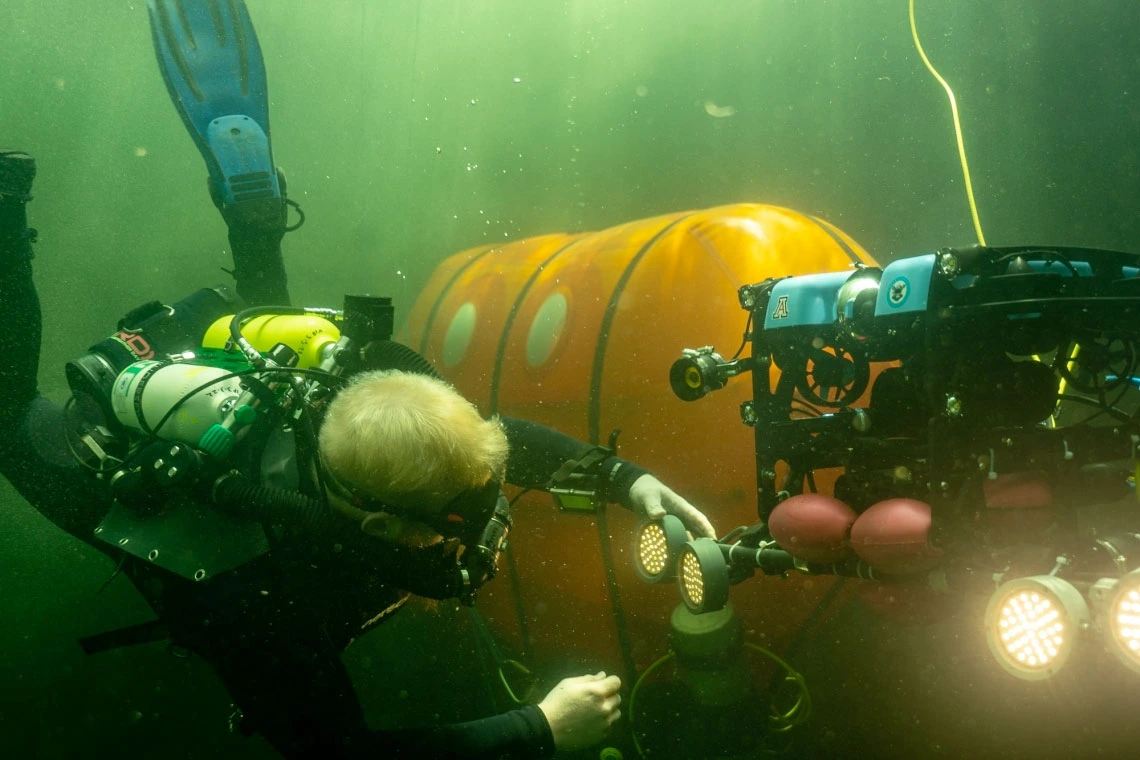College of Information Science Professor and Inventor Winslow Burleson Spends the Night 20 Feet Underwater
iSCHOOL IN THE HEADLINES

Scientific diver Brandon Carr swims beside the underwater robot used to collect samples in the Biosphere 2 ocean during a May 2023 experiment to test the the Ocean Space Habitat, seen behind Carr. University of Arizona professor Winslow Burleson invented the inflatable tent-style habitat alongside professional diver Mike Lombardi. Burleson spent a night in the tent and processed samples collected by the robot. Photo courtesy Jona Silverstein.
What’s it like to spend the night 20 feet underwater in a tent you co-invented?
That’s what Mark Brodie of KJZZ wanted to find out when he interviewed Winslow Burleson, professor in the College of Information Science at the University of Arizona.

Winslow Burleson in the Ocean biome at Biosphere 2. Photo courtesy Winslow Burleson.
Burleson, a scholar, social inventor, artist and educator whose research areas of focus include human-computer interaction, learning sciences and health science design, designed and built the Ocean Space Habitat with Michael Lombardi of Rhode Island’s Lombardi Undersea LLC. They patented the technology in 2018.
Burleson successfully tested the new technology overnight at Biosphere 2, the world’s largest controlled environment dedicated to understanding the impacts of climate change. The ocean biome at Biosphere 2—the Marine Mesocosm—is a complete ocean system originally designed to simulate a Caribbean reef. The world’s largest enclosed mesocosm dedicated to innovative research and education on coral reef resilience, according to Biosphere 2 literature, it has a surface area of 500 meters and a volume of 2.6 million liters.
Burleson’s Ocean Space Habitat, which is about the size of a two- or three-person tent, was created to allow researchers to stay underwater longer. It is essentially a fabric tent anchored to the ocean floor that floats above the floor, creating a bubble of breathable air. Because that bubble would only last so long due to exhaling, however, Burleson and Lombardi have created a scrubber that acts like a scuba diving rebreather, allowing the “camper “to breathe the machine-circulated atmosphere in the tent.
“It was pretty magical to spend the night in the tent,” says Burleson in the KJZZ interview. “You’re underwater, so you’re ready to go out and explore. We had the opportunity to go from the tent and do genetic sampling and bring those samples back to the tent to undertake scientific work.”
Listen to the full interview, which ran on KJZZ on December 28, 2023: “Why a University of Arizona professor went camping—20 feet underwater.”
Burleson was also interviewed about his underwater experience at Biosphere 2 by University of Arizona Communications in June 2023: read the interview here.
Burleson, who joined the College of Information Science in 2019, has been recognized as a Distinguished Member of the Association for Computing Machinery, a pioneering innovator advancing the digital age. The National Academy of Engineering recognized him as one of the “nation’s brightest young engineering researchers and educators.” Prior to joining University of Arizona he was an associate professor at New York University, where he served as PI for the NSF Experiential Supercomputing: A Transdisciplinary Research and Innovation Holodeck grant. He earned a BA in Bio-Physics from Rice University, Master of Science in Engineering in Product Design from Stanford University, and a PhD in Media Arts and Sciences from MIT. He has authored over 100 scholarly articles, holds eleven patents, and twice received Time Magazine’s Top Inventions of the Year Awards.
Learn more about Winslow Burleson on his faculty page, or learn how you may support research and other College of Information Science faculty initiatives.

